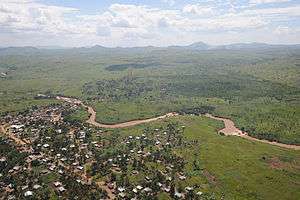Ituri Province
| Ituri Province | |
|---|---|
| Province | |
_-_Ituri.svg.png) | |
| Coordinates: 1°50′N 29°30′E / 1.833°N 29.500°ECoordinates: 1°50′N 29°30′E / 1.833°N 29.500°E | |
| Country |
|
| Capital | Bunia |
| Largest city | Bunia |
| Government | |
| • Governor | Jefferson Abdallah[1] |
| Area | |
| • Total | 65,658 km2 (25,351 sq mi) |
| Area rank | 16th |
| Population (2005 est.) | |
| • Total | 4,241,236 |
| • Rank | 4th |
| • Density | 65/km2 (170/sq mi) |
| Official language | French |
| National language | Swahili |
| Website | http://provinceituri.co/ |
Ituri is one of the 26 provinces of the Democratic Republic of the Congo.[2] Its capital is the city of Bunia.[3]
Geography
The Ituri Rainforest is in this area. It is located northeast of the Ituri River and on the western side of Lake Albert. It has borders with Uganda and South Sudan. Its five administrative territories are:
Ituri is a region of high plateau (2000–5000 meters) that has a large tropical forest but also the landscape of savannah. The district has rare fauna, including the okapi, the national animal of the Congo. As for flora, an important species is Mangongo, whose leaves are used by the Mbuti to build their homes.
Economy
The Kilo-Moto gold mines are partly located in Ituri. In the beginning of the 21st century, petroleum reserves have been found by Heritage Oil and Tullow Oil on the shores of Lake Albert.
History
Ituri, as Kibali-Ituri, was a province of the DRC from 1962-1966. Prior to the adoption of the 2006 Constitution of the Democratic Republic of the Congo, the legal status of Ituri was a topic of some dispute. From the beginning of the Second Congo War in 1998, it was held by soldiers of the Uganda People's Defense Force (UPDF) and the Ugandan-backed Movement for Liberation faction of the Rally for Congolese Democracy (RCD-ML). In June 1999, the commander of UPDF forces in the DRC, Brig. Gen. James Kazini, ignored the protests of RCD-ML leaders and re-created the province of Kibali-Ituri out of the eastern section of the northeastern Orientale province. It is almost always referred to simply as Ituri. The creation of the new province under the governorship of a Hema contributed to the start of the current Ituri conflict, which has caused thousands of deaths. Most official cartographers did not include the new province, and those referring to it as a "province" rather than a "region" were sometimes viewed as having a pro-Uganda bias. With the new constitution, Ituri's status as a province was finally settled.
Approximate correspondence between historical and current province
| Belgian Congo | Republic of the Congo | Zaire | Democratic Republic of the Congo | ||||||
|---|---|---|---|---|---|---|---|---|---|
| 1908 | 1919 | 1932 | 1947 | 1963 | 1966 | 1971 | 1988 | 1997 | 2015 |
| 22 districts | 4 provinces | 6 provinces | 6 provinces | 21 provinces + capital | 8 provinces + capital | 8 provinces + capital | 11 provinces | 11 provinces | 26 provinces |
| Bas-Uele | Orientale | Stanleyville | Orientale | Uele | Orientale | Haut-Zaïre | Orientale | Bas-Uele | |
| Haut-Uele | Haut-Uele | ||||||||
| Ituri | Kibali-Ituri | Ituri | |||||||
| Stanleyville | Haut-Congo | Tshopo | |||||||
| Aruwimi | |||||||||
| Maniema | Costermansville | Kivu | Maniema | Kivu | Maniema | ||||
| Lowa | |||||||||
| Kivu | Nord-Kivu | Nord-Kivu | |||||||
| Kivu-Central | Sud-Kivu | ||||||||
Government
An Ituri Interim Administration was formed through the efforts of the Ituri Pacification Commission, a commission sponsored by the United Nations Organization Mission in Democratic Republic of the Congo (MONUC, abbreviation of the French name "Mission de l'Organisation des Nations Unies en République Démocratique du Congo") that was set up, after much initial delay, in 2003 after the pull-out of Ugandan troops from the district. It led to the creation of the Ituri Interim Assembly, which elected an administrator and an assembly chairperson; the current assembly chairperson is Petronille Vaweka, who is also the sole deputy for the district to the National Assembly in Kinshasa.
The Interim Assembly will be reconstituted or replaced by a provincial assembly under the 2006 constitution. An election for the governor and vice-governor will also be held, and the district will be re-created as a province of the DRC.
Presidents, later governors, of Kibali-Ituri from 1962-1966
- September 1962 - 28 December 1966 Jean Foster Manzikala
Governors of Ituri since 1999
- *1999* Adele Lotsoye Mugisa (appointed by James Kazini)
- December 1999 - early 2001 Ernest Uringi Padolo
- December 2001 - November 2002 Joseph Eneku
- February 2002 - ? Jean-Pierre Mulondo Lonpondo
- April 2003–2016 Emmanuel Leku Apuobo
- March 2016-present Jefferson Abdalla
Demographics

The population is composed primarily of Alur, Hema, Lendu, Ngiti, Bira and Ndo-Okebo, with differing figures on which one of the groups constitutes the largest percentage of the population in the province. The Mbuti, a pygmy ethnic group, reside primarily in the Ituri forest near the Okapi Wildlife Reserve, although some Mbuti have been forced into urban areas by deforestation, over-hunting and violence.
See also
References
- ↑ "RDC: liste de nouveaux gouverneurs de province élus". Radio Okapi. 26 March 2016. Retrieved 21 May 2016.
- ↑ Central Intelligence Agency (2016). "Democratic Republic of the Congo". The World Factbook. Langley, Virginia: Central Intelligence Agency. Retrieved 10 May 2016.
- ↑ "Provinces of the Democratic Republic of Congo". Statiods.com.
Further reading
- WOLTERS, S., 2005. Is Ituri on the Road to Stability? An update on the current security situation in the district. Pretoria: Institute for Security Studies.
.jpg)